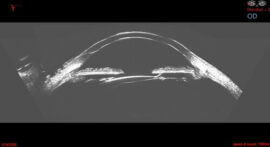Q: Do you need to be an experienced imager to perform the scans?
A: Although experience and knowledge as an ophthalmic sonographer is required to know where to place the scan and what to look for, the skills needed to capture a good, clear UBM scan are not necessary when using the ArcScan Insight 100. The Insight 100 is much easier to use than a probe since it is robotic- the machine ensures repeatable and accurate scans every time.
Q: What do you use for the barrier to the patient’s eye? How do you clean the transducer?
A: The transducer is always clean because it never comes into contact with the patient. We use a disposable patient interface, the EyeSeal, that prevents the patients’ eyes from ever touching the machine. Saline solution is filled within the EyeSeal and distilled water is filled within the instrument on the other side of the EyeSeal membrane, where the transducer sits. The EyeSeal acts as a ‘swim goggle’. The EyeSeal, saline solution, and distilled water is disposed of between patients, and the machine is wiped down.
Q: Do you numb the eye?
A: No, not at all since nothing is touching the eye. The imaged eye is very comfortable within the saline. The fellow eye can be held shut by the patient’s hand or an eye patch to prevent blinking or dryness.
Q: How do you handle “difficult” patients? What ages is this able to be used with?
A: There will always be limitations with difficult patients, with any instrument. The Insight 100 has FDA clearance for 18+. The Insight 100 is ergonomically designed to be very comfortable, as long as the patient can sit down. It is a very comfortable position with a chin rest and hand rest to hold on to. Tape can be used to hold older eye lids open, or a speculum, if needed.
Q: Is the machine moveable?
A: The Insight 100 should not be moved. The ultrasound probe on the inside is quite sensitive. The fluidics reservoir is on the outside of the unit and connected by tubing. The instrument is not moved throughout the clinic and is usually in a pre-test area.
Q: How long does a typical exam last?
A: Depending on which scan the operator is performing, the exam shouldn’t last more than 5-6 minutes for both eyes. The longest part of the exam is filling the machine and setting up the patient.
Q: Can you change the position of the eye for peripheral images?
A: Yes, but there is a limit on the position of the probe. The Insight 100 does have central and peripheral fixation targets, which can be rotated in any manner around the clock hour.
Q: Regarding data management, is the Insight 100 able to download a modality worklist?
A: Yes, the Insight 100 does have DICOM capabilities.
Q: Can the Insight 100 have the ability to get an associated image of where you took the ultrasound of the eye?
A: There is a live video image of the eye on the operator screen. It will automatically tell the operator which meridian or clock hour you took the image, what was the patient orientation, and a reference image of the area scanned. Each of the images captured will give detailed data to which clock hour they were taken.

